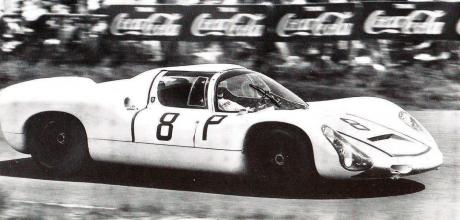Zimmerised 910 - the strange history of chassis Porsche 910-013
In the early 1970s, a racing enthusiast in possession of an accident-damaged 910 decided to transform the Porsche into a no-excuses sports car for the road. Calling in leading experts, he succeeded in creating an automobile of rare sculptural excellence…
Words Karl Ludvigsen
Photography Porsche Corporate Archives, Ludvigsen Partners
You wouldn’t want to refer to a racing Porsche as a sow’s ear, but the transformation of the car you see here into a ‘silk purse’ would qualify for just such a makeover. It began with a Type 910. Let’s begin by getting an idea of just what kind of Porsche this was.
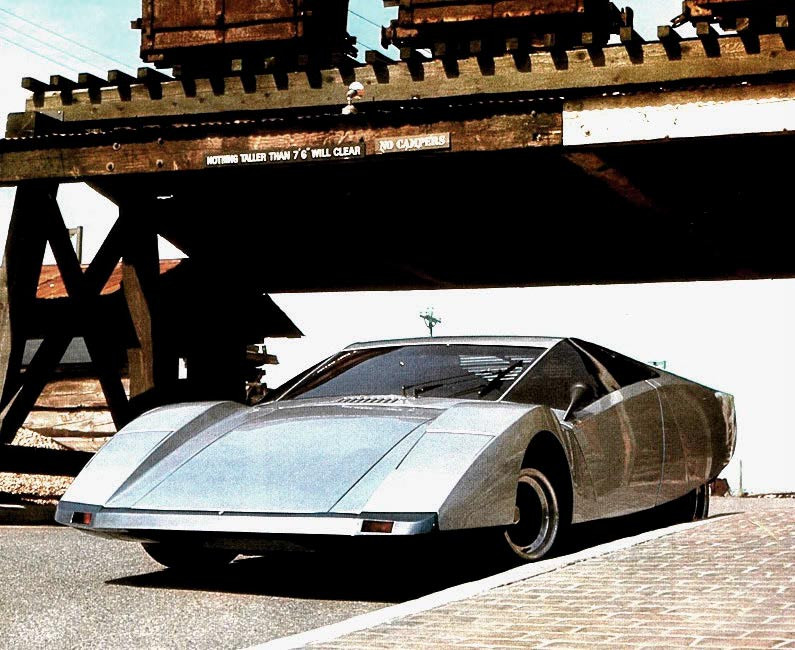
Above Lurking at the kerb, Zimmer’s 910 S was a completely new vision of a sports car in ultra-modern form, forecasting the speed of which it was capable.
The 910 was the first big step up from the 906 (Carrera 6), serving as the launch vehicle for Ferdinand Piëch as engineer and his mission to thrust Porsche forward as a major force in motorsport. Starting in 1966, the company built some thirty examples of the 910 for long-distance endurance racing. Each was powered by either by a fuel-injected two-litre flat six (creating a 910/6) or an ex-Formula One 2.2-litre eight-cylinder engine (creating a 910/8). In 1967, the factory team of 910s scored class victories in the 24 Hours of Daytona, 12 Hours of Sebring, the 1,000-kilometre races at Monza and Spa, the Targa Florio, the 24 Hours of Le Mans and — pause for breath — the 12 Hours of Reims.
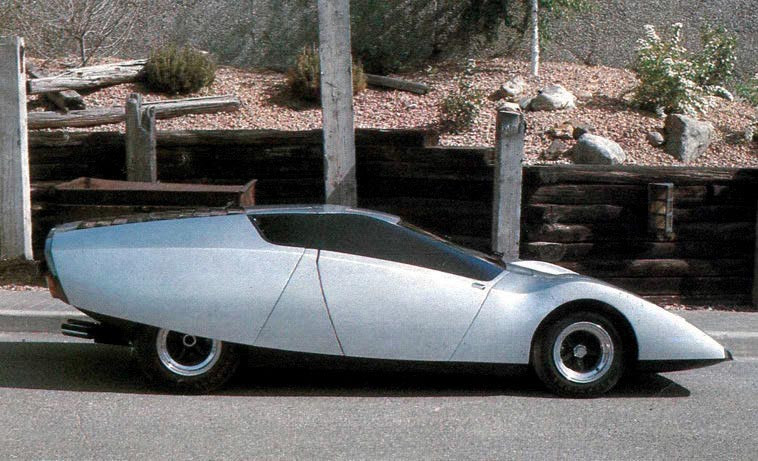
A 910 won the 1,000-kilometre race at the Nürburgring outright. The car was driven by Joe Buzzetta and Udo Schütz. Paul Hawkins and Gerhard Koch placed second at the controls of chassis number 910-013. In 1968, the same car was in the hands of Italian race ace, Alberto Luti, who entered 910-013 several times and competed with it once at Mugello. Coming out of storage, the Porsche was acquired by Canada’s Burt Kuehne. Supported by accomplished Porsche pilot, Harry Byztek, Kuehne raced 910-013 throughout the 1972 season. By then, 910-013 (a 910/6) was due a major overhaul.
Over the border, in Brooklyn Center, Minnesota, the car came to the attention of Jack Zimmer, owner of Porsche special-equipment company, Carousel Racing. Seeing the Porsche as the basis of a special for club racing in the USA, Zimmer crossed Kuehne’s palm with silver. When the Canadian travelled south to deliver the 910, however, he flipped his car transporter on its roof. The damage was severe enough to cause scrapping of the original coupe body.
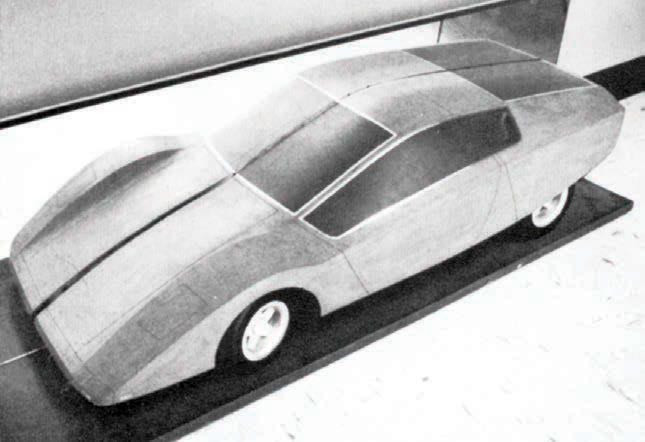
This didn’t daunt Jack Zimmer, but the Sports Car Club of America (SCCA) put a stick in his spokes. The organization decided to merge sports-racing classes A and B into a single category, which included heavy-duty Can-Am-type cars. “Because the Porsche would be less than competitive,” wrote Joe Rusz, “Zimmer decided to use its still-respectable power, amounting to top speed of 175mph, to propel a one-of-a-kind street coupe capable of rivalling the best Italian dream cars, both in looks and performance.”
A tall order. After all, America had few of the enterprises the twenty-first century would bring in the way of freelance automotive stylists and coachbuilders. Zimmer, however, had been reading his Road & Track. He remembered how Reventlow-built Scarabs, worldbeaters in their heyday, benefited from a clever designer and a talented fabricator. The former was Chuck Pelly, responsible for the Scarab’s good looks, the latter was metalworker, Dick Troutman, ably assisted by his business partner, Tom Barnes.
TAKING CARE OF BUSINESS
Both Pelly and Troutman were still on the job in California. Pelly had just established Designworks USA, an independent industrial design contractor. Troutman was working out of his Culver City headquarters, though Barnes had departed. Ready to rumble, Zimmer considered them “the best in the business”, but what of the appearance of the Porsche he wanted them to work on? The options were infinite.
According to Zimmer, “Pelly and I made some initial sketches of what we thought the ultimate Porsche street machine should look like.” Inspiration came from a motor show stunner the Porsche’s new owner fancied. As the bill payer, of course, Zimmer was influential. He remembered a Pininfarina design turning heads at the 1969 Turin Salon. It was the work of Filippo Sapino, who had been given the task of clothing a mélange provided by Ferrari. Based on the chassis of a 312P sports racer, the car was equipped with the six-litre engine of a Can-Am Prancing Horse, though with nothing inside it.
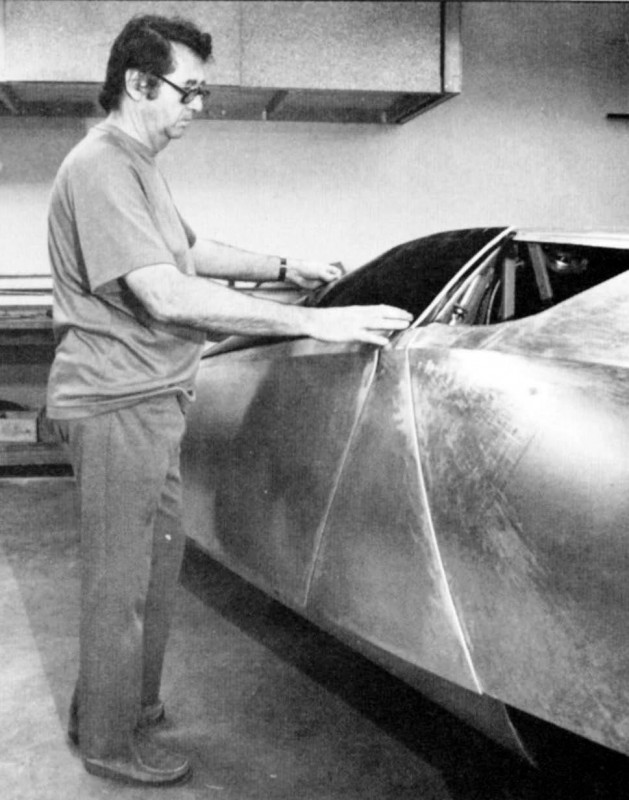
This was the Ferrari 512S Berlinetta Speciale, and it put the Americans on the right track. Ultra-low and striking in yellow, it majored on crisp lines, while eschewing the ‘origami’ look some designers of the period were favouring. The Speciale’s influence on the Zimmer Porsche is clear, but Pelly adopted lines unmistakably his, creating a superbly clean and chiselled coupe body with hippy flanks and a plunging nose. Incidentally, Pelly exhibited the car once, on the West Coast, winning for him and his creation the 1975 California Design Excellence Award.
With the look taking shape, Pelly asked colleague, Ed Stulik, to create a model. Stulik did this quarter-scale, using the designer’s ‘cheat’ of a mirror, so that only half the car had to be modelled. After this was perfected, fullscale drawings of the body were made. Stulik worked with Troutman on the fabrication of the wooden buck responsible for guiding the final form.
PEDAL TO THE METAL
Aluminium and steel sheets — as specified — were placed on the mock-up, cut to size and shipped to the California Metal Shaping Company in Los Angeles for rough forming. Their stampings returned to Troutman’s shop, where the coachbuilder shaped, fitted and welded the pieces into a homogeneous form. Aluminium was used for all body panels except the tub and the roof, where steel sections were needed for rigidity. Side windows were acrylic, while a Cadillac windscreen was trimmed to fit. The glow of the finished car’s Porsche metallic-silver lacquer is to the credit of Creative Car Craft, operating out of Hawthorne, California.
Conversion of 910-013’s rolling chassis to the semifinal version of the 910 S — as Zimmer named it — occupied Troutman for almost fourteen months. While he was forming its body, the chassis was stripped, sand-blasted, X-rayed, magnafluxed and straightened. Meanwhile, Zimmer supervised the fabrication of many custommade components, including door handles, hinges, moulded-in steel bumpers and a dashboard hand-crafted by Californian artisans and using 911 instruments. New substituted for old throughout the car.
Suspension components and running gear were restored or, in most cases, replaced with new parts purchased from the Porsche factory’s racing department. Every nut and bolt (titanium) was replaced. The 910 S’s ventilation system and electric pop-up headlamps were taken from the 914/6, while tail lamps were from an Audi. Porsche black leather covered the interior, including Lotus Europa seats, finished with tartan cloth inserts.
The original aluminium lateral fuel tanks were converted into forty-five-litre cells on both sides of the car. Wider wheels — 9.5x13 inches at the front and 13x13 at the rear — wore Firestone racing tyres. The most significant modification was to use a 2.8-litre engine, a decision made after the Zimmer-Porsche was first driven early in 1975, close to three years after the project started.
“After we had run the car with the original rebuilt two-litre engine,” said Zimmer, “we found the increased weight of converting from a race car to a street machine was just too much for the given displacement. By my standards, the car was slow. I sent the original engine, stamped 910-014, to Andial. There, it was built into a 2.8-litre unit using the original internal titanium valve gear, but with bigger valves.” The resulting output was 280bhp, a welcome up-tick from the original 220bhp. “I had good friends at Mahle,” Zimmer added. “They helped me with special cylinders and pistons. I never did get around to running fresh performance tests with the Andial 2.8-litre engine, but it was flat-out faster. Running it at Donnybrooke through turns one and two, then braking at turn three, was hilarious. Get hard on the binders and the car would leap from the inside braking area to the outside of the track. When the corner workers at turn three saw me coming, they would desert their post en-masse. Inadequate braking was the limiting factor of the 910 S. My last but unfinished project with the car was to change over to 908 front and rear suspension, including bigger, ventilated brakes. The 910 S was bloody fast, but you couldn’t stop it in a straight line. Funny, but scary.”
Although Zimmer said he eschewed performance timing, some figures do exist for his coupe’s acceleration. Specifically, it took 1.7 seconds to reach 30mph, 4.4 for 60, 6.9 to 80 and 11.2 seconds to 100.
The standing quarter-mile was covered in 12.5 seconds, with a final speed of 134.9mph. Top speed was given as 187mph, a nice round 300km/h. This was outstanding performance for the 1970s, likely matching the potential of the Pininfarina Ferrari inspiring the car’s design. Additionally, Zimmer said his 910 S rode better than his 911 Turbo, was much quicker and, indeed, nicely noisier. “The whine of the cams at 8,500rpm, screaming behind your head, somehow sounded better than the less-busy whoosh of the 930.”
WHO GOT THE KEYS TO MY ZIMMER
In subsequent years, Zimmer’s Carousel company became an Audi dealer. In this format, the business was bought by local SCCA racer, Tom Countryman, complete with the Zimmerised Porsche. The tender loving care such a car required was not in the offing. Indeed, an unknown party decided the car would best be converted back to a Porsche and discarded the work of Pelly and Troutman. In the garb of an original 910, 910-013 and engine 910-014 is thought to have been sold to a buyer somewhere in Japan.
In its day, the 910 S was a stunningly handsome sports car and outpaced all other contemporary efforts to create advanced twoseater designs in America.
Nonetheless, it received little recognition. Zimmer admitted that he was partly to blame. The 910 S, so he reasoned, should have been a star at all motor show venues, from Pebble Beach to New York City. He was, however, worried about possible transport damage — shades of the accident which made 910-013’s chassis available — and about the petty vandalism prevalent at most auto shows.
We haven’t even the suite of professional images that would have captured such an icon for eternity. What we do have are the pictures accompanying this article. They clearly demonstrate the 910 S was a gorgeous car in its day and an American achievement worth celebrating.

THE 910 S SHOULD HAVE BEEN A STAR AT ALL MOTOR SHOW VENUES, FROM PEBBLE BEACH TO NEW YORK CITY
Above The sheer lines mandated by Pelly’s design made heavy demands on the skill of Dick Troutman, who was working to a wooden buck and succeeded in manipulating its aluminium Top right Chuck Pelly is at the center and Jack Zimmer on the right as they survey their joint achievement Below In profile, the 910 S most resembled its Pininfarina inspiration, but with the convenience of side-opening doors.
IN MOST CASES, NEW PARTS PURCHASED FROM THE PORSCHE FACTORY’S RACING DEPARTMENT
Above At its nose, the 910 showed its 906 origins, but also demonstrated how Porsche was serious about its endurance racing programme.
Below Several quarter-scale models made by Chuck Pelly’s colleague, Ed Stulik, resulted in this mirror-image depiction of the car all parties agreed to build on the Porsche chassis
SUPPORTED BY ACCOMPLISHED PORSCHE PILOT, HARRY BYZTEK, KUEHNE RACED 910-013 THROUGHOUT THE 1972 SEASON
Facing page Porsche poster celebrating the 910 locking out the top four places at the 1967 1000km of Nürburgring, a race which saw chassis 910-013 finish second at the hands of Paul Hawkins and Gerhard Koch, while a flat-eight- powered 910 finished in fourth, leaving the six-cylinder variants to take all of the available podium places.


